Rising 1,142 feet above the surrounding red desert in the southern part of the Northern Territory in Central Australia, Uluru, formerly known as Ayers Rock, is one of Australia’s most recognizable natural landmarks. A UNESCO World Heritage site since 1987 for both its natural and cultural values, Uluru is a great bucket list destination for a road trip through Central Australia.


The Red Centre Way Is the Ultimate Australian Family Road Trip From Alice Springs to Uluru
One route is The Red Centre Way, a journey that spans over 700 miles in a circular trip across an ever-changing landscape between Uluru and Alice Springs, the nearest large town to Uluru, which is located pretty much in the exact center of Australia.
This trip begins in Alice Springs and follows a route that allows families to enjoy the best of Australia’s great outdoors with stunning gorges, canyons, and swimming holes. The main attraction is, of course, Uluru, where you can learn about the local Indigenous culture before returning to Alice Springs.
While it may seem daunting to embark on an off-road adventure through Central Australia, rest assured that road trips are entrenched in the Australian psyche and are a popular choice for families on vacation. This route in particular is an ideal introduction to the diversity of the landscape of the vast country and its culture. Here’s everything you need to know about driving The Red Centre Way with your family.
The best time to take a road trip on The Red Centre Way
Although Central Australia is incredible all year round, the most comfortable time to visit is between May and September when the maximum daytime temperature is usually between 68°F and 86°F. From June to August it’s winter in Australia, and overnight temperatures drop, so it’s advisable to pack warm clothing and be prepared. September is ideal if you wish to see the desert wildflowers blooming around Uluru, a scene that family members of all ages can appreciate.
An overview of The Red Centre Way route
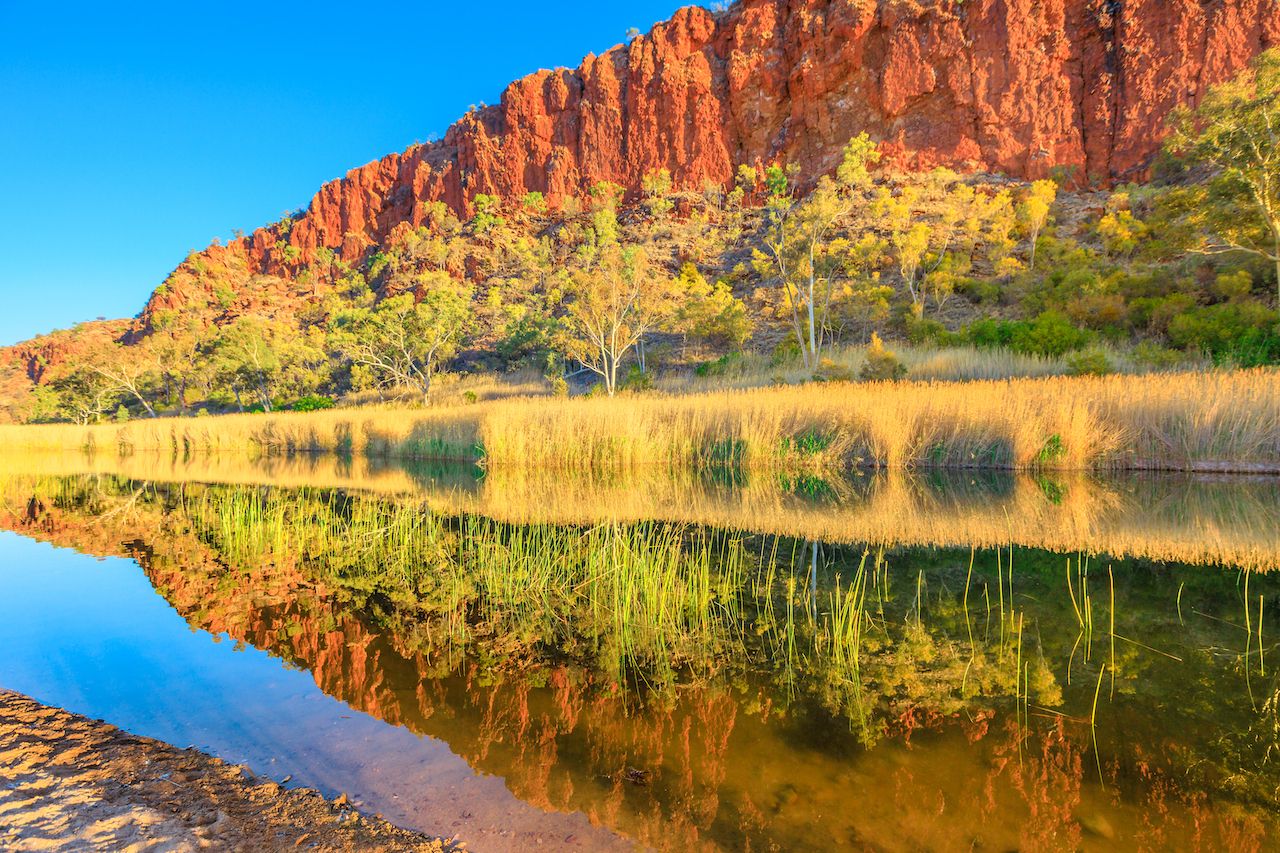
Photo: Benny Marty/Shutterstock
The Red Centre Way road trip through Central Australia is ideal for families, with plenty of outside fun and very limited WiFi to distract the kids from the great outdoors. Beginning in Alice Springs, the route heads west to explore the West MacDonnell ranges and their amazing gorges and swimming holes. The route then follows the Mereenie Loop Road, a red dirt track that connects the West MacDonnell Ranges with Kings Canyon, Australia’s version of the Grand Canyon. After Kings Canyon, the road takes you to Uluru, which can be experienced in a number of memorable ways. The road trip comes to an end when you depart Uluru and drive all the way back to Alice Springs, this time via the main highway.
The whole trip can be completed in five days, but that might feel rushed as you won’t have much time to enjoy the highlights. Seven days is ideal, and 10 days is pure outback bliss.
How families can experience The Red Centre Way
Alice Springs
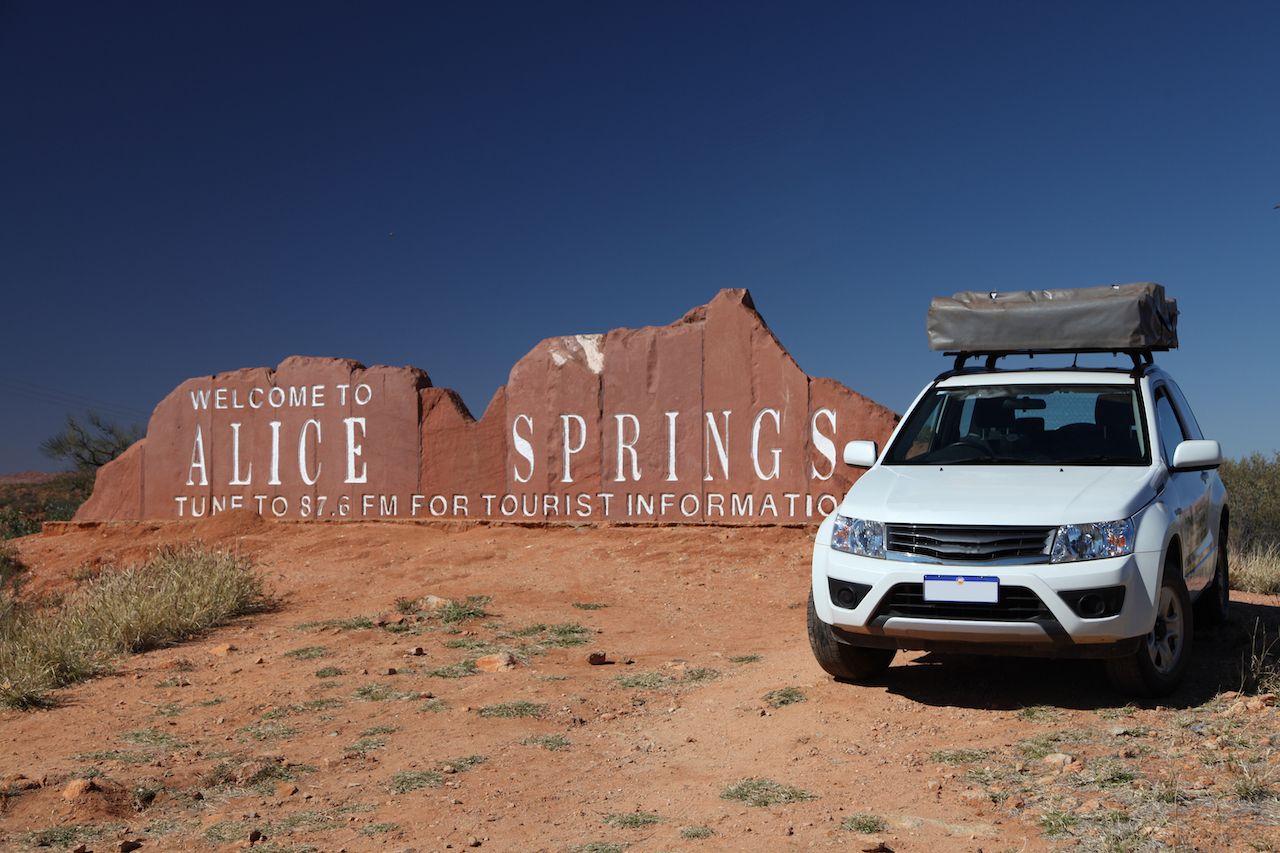
Photo: pierdest/Shutterstock
The starting point of any Central Australia road trip is Alice Springs. It’s the only decent-sized town for around 932 miles and is famous for its beautiful desert landscapes, opportunities for adventure, and Aboriginal cultural experiences. Located between the East and West MacDonnell Ranges, Alice is reached via domestic flights from most capital cities in Australia.
There are two important things that you need to get in Alice Springs, a 4WD vehicle and a Mereenie Loop pass. The Mereenie Loop pass is required to drive the Mereenie Loop Road, an iconic red dirt track along The Red Centre Way. It costs around $4, and passes are available at the Alice Springs Visitor Information Centre.
We recommend that you book a 4WD well before you arrive. Vehicles can be hired with or without camping gear; however, we recommend opting to rent as there are some amazing places to camp along the West MacDonnell Ranges.
If there is a spare day in Alice Springs before heading out, a visit to the Alice Springs Desert Park is popular with families for the opportunity to learn about the interesting animals and plants in the area. The park has great features, such as a walk-through bird aviary and the Nocturnal House, a purpose-built section showcasing the area’s nocturnal animals such as the bilby, mala, and thorny devil.
The West MacDonnell Ranges
Heading west from Alice Springs, there is no doubt that exploring the swimming holes and gorges within the Tjoritja West MacDonnell National Park (aka the West Macs) will be a highlight of your family road trip. An ancient landscape that has been sculpted over time by the elements of nature, the West Macs are dramatic mountains with semi-permanent and permanent waterholes, and a red desert topography that contrasts with the green plant life and blue sky. It’s also a refuge for rare wildlife and plants, including the peregrine falcon.
Swimming and camping in The West MacDonnell Ranges

Photo: Roadwarrior Photography/Shutterstock
The route passes by Ellery Creek Big Hole, where you can pull up and enjoy a plunge in the cool creek that cuts through the high gorge walls in spectacular fashion. If time allows, there is a wonderful two-mile hike called the Dolomite Walk that takes you through the surrounding formations and offers stunning views.
Another scenic swimming spot is Ormiston Gorge, located a little further west. Possibly the most photogenic waterhole along The Red Centre Way, here you can enjoy deep water swimming, sand, and the native white gum trees that line the creek. A short but sweaty 20-minute hike up to a lookout offers amazing views of the creek as it cuts through the West MacDonnell Ranges.
Many who drive The Red Centre Way choose to camp at these waterholes for a night or two before making their way through to Kings Canyon via the Mereenie Loop Road. Camping at both Ellery Creek and Ormiston Gorge is available first-in first-served for a fee using an honesty box system. It cost about $6 for a family at Ellery Creek and $18 at Ormiston Gorge. Both campgrounds have toilets and barbecues but only Ormiston Gorge has showers and a kiosk selling ice-creams, coffee, and snacks.
Finke River, the oldest riverbed in the world
Just past Ormiston Gorge is Finke 2 mile, a 4WD-accessible-only camping area with no facilities. Here you can take an opportunity to splash around in the Finke River, said to be the oldest riverbed in the world. It’s not unusual to have the whole place to yourself, except for the flocks of brightly colored budgerigars that flitter around the white gums that grow in the sandy ground beside the creek.
Redbank Gorge
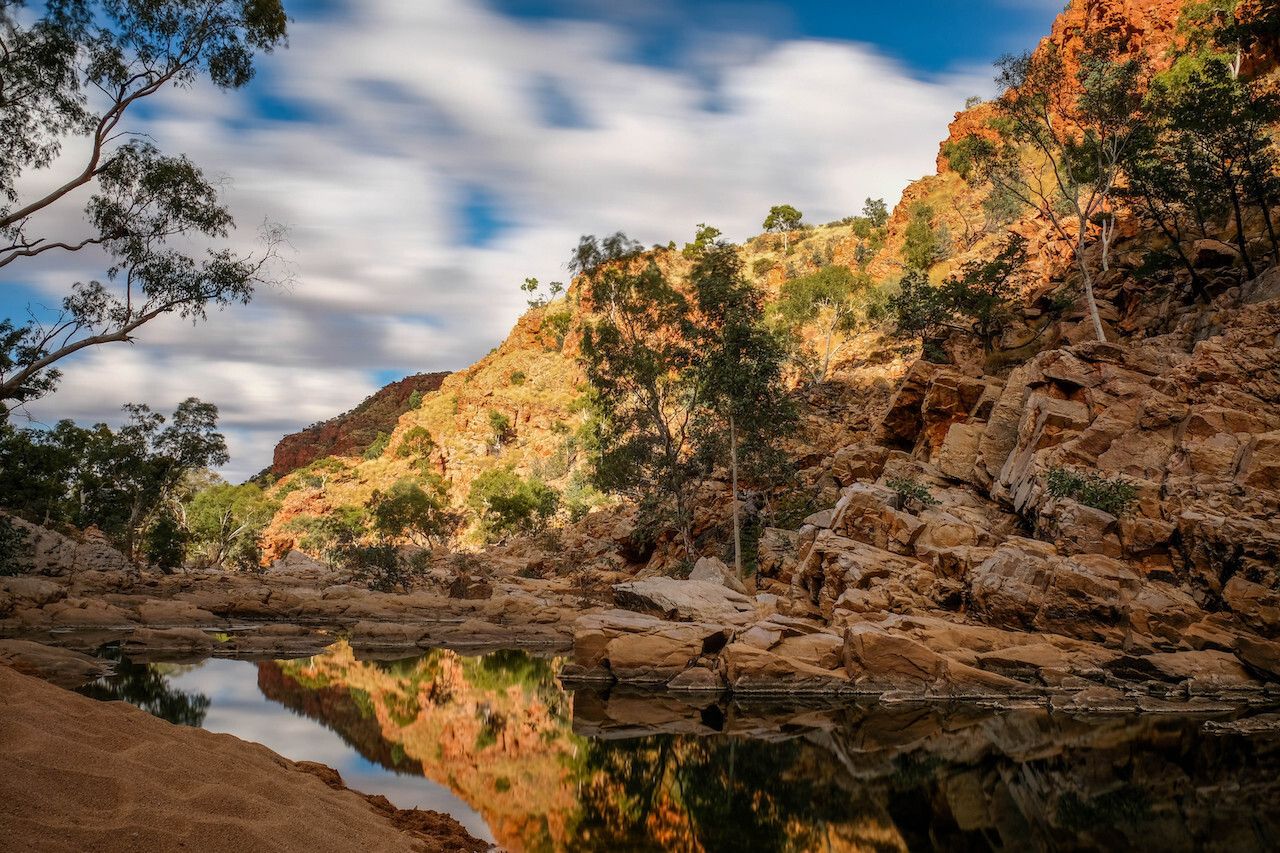
Photo: Christina Fink/Shutterstock
Located 97 miles west of Alice Springs, Redbank Gorge is the last wild swimming opportunity along The Red Centre Way. A hike along a river creek bed is required to reach the permanent waterhole at the end. Depending on recent rain, sometimes this hike is an easy stroll along a dry river bed, and other times it takes up to an hour scrambling over rocks. Either way, it’s worth the hike in for the opportunity to swim in this remote gorge with yellow-tinged water that contrasts beautifully with the red gorge walls and blue cloudless sky of Central Australia.
Camping is available here as well on a first-in first-served basis, but given the long hike into the actual waterhole with swimming gear, food, and water supplies, it’s not as appealing as Ormiston Gorge or Ellery Creek where you can take a dip within a few minutes stroll of the campground.
The Mereenie Loop Road
The Mereenie Loop pass will be required for the next section of The Red Centre Way. Make sure it’s in your glove box or somewhere handy, and get ready to tackle the Mereenie Loop Road, an unsealed, corrugated track that links the West Macs with Kings Canyon in Watarrka National Park.
The road itself is only around 87 miles long, but it can take two to three hours due to the conditions. This stretch of the route can be particularly dangerous with wildlife on the track, such as wild brumbies and camels. While driving the Mereenie Loop Road, expect amazing outback scenery with tons of red and green that contrast magically with the blue of the outback sky.
Kings Canyon

Photo: Jessica Palmer/Family Holiday Destinations
Located in Watarrka National Park, Kings Canyon is seriously underrated and at a great point of the route to stop and explore the area for a couple of nights. Kings Canyon Resort is around six miles from Kings Canyon itself and offers glamping facilities as well as a campground and hotel rooms.
The nearly four-mile Kings Canyon Rim Walk is a must-do here, offering a decent leg workout in the initial ascent, epic views, and the chance to experience the Garden of Eden, a hidden oasis in the middle of an otherwise red and barren landscape. There is also a more relaxed option in the almost two-mile return Kings Creek Walk, which meanders up the middle of the canyon at ground level.
Uluru-Kata Tjuta National Park
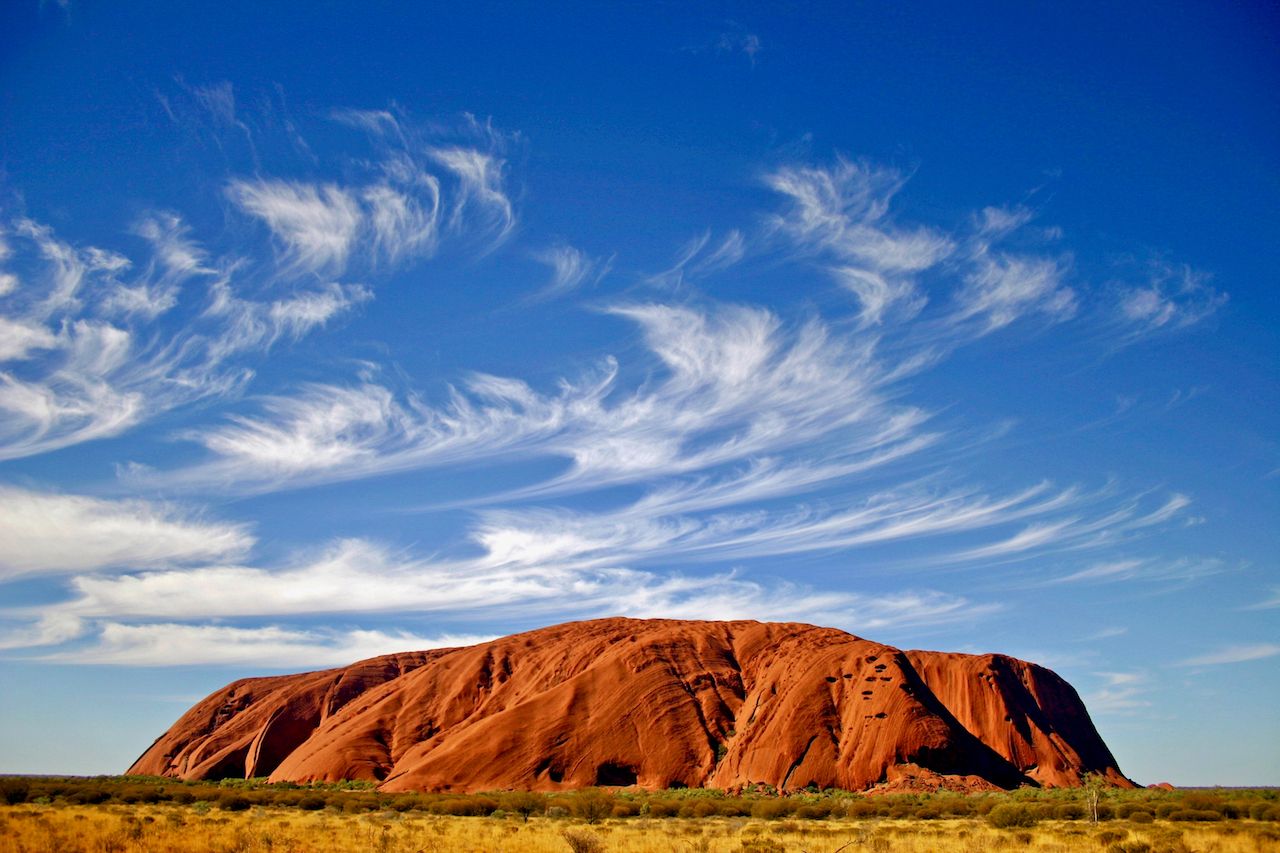
Photo: Stickybeak TV/Shutterstock
The next section of the route takes you to Uluru, located within the Uluru-Kata Tjuta National Park. This stretch of the journey takes around three hours (186 miles) from Kings Canyon Resort, and to be honest, it’s probably the least exciting part of the whole road trip. There is no mobile phone coverage for long stretches, so stock up on snacks and make sure the kids are strapped in and occupied.
You will spot Uluru in the distance long before you reach it, but don’t be tricked by Mount Connor, another giant rock that dominates the otherwise flat landscape. You can tell the difference between the two as Mount Connor has a completely flat top, whereas Uluru has more of a domed one.
There are many unique ways to experience Uluru; however, hiring a pushbike and cycling around it is a memorable option for families. Pushbikes can be rented from Outback Cycling, a private operator next to the Uluru-Kata Tjuta Cultural Centre, and the whole circuit is around nine miles. The walking trail around Uluru is a little shorter at around six miles, but a much easier and very popular route is the Mala Walk, which at one mile features caves with significant Indigenous heritage and examples of ancient rock art by Indigenous people.
Both kids and adults alike will love the sunrise Field of Lights tour, during which a bus transports visitors to a secret location to view hundred of thousands of multicolored solar-powered lights spread over an area the size of seven football fields. The Field of Lights is a long-running art installation by British artist Brue Munro who is best known for immersive large-scale light-based installations. Uluru’s Field of Lights can be viewed by a tour at sunrise, sunset, and after dark, but sunrise is particularly enjoyable — when the sky becomes lighter, Uluru itself in the background really stands out, changing from an earthy brown to a bright orange through to a flaming red as the morning sun rises higher in the sky.
Another great way to experience Uluru as a family is by camelback with Uluru Camel Tours. This camel farm is an animal-first farm with rules in place to ensure the welfare of these gentle giants. A number of tours are offered, but the Sunset Camel Tour is popular with families and includes a one-hour ride in the desert landscape with views of Uluru.
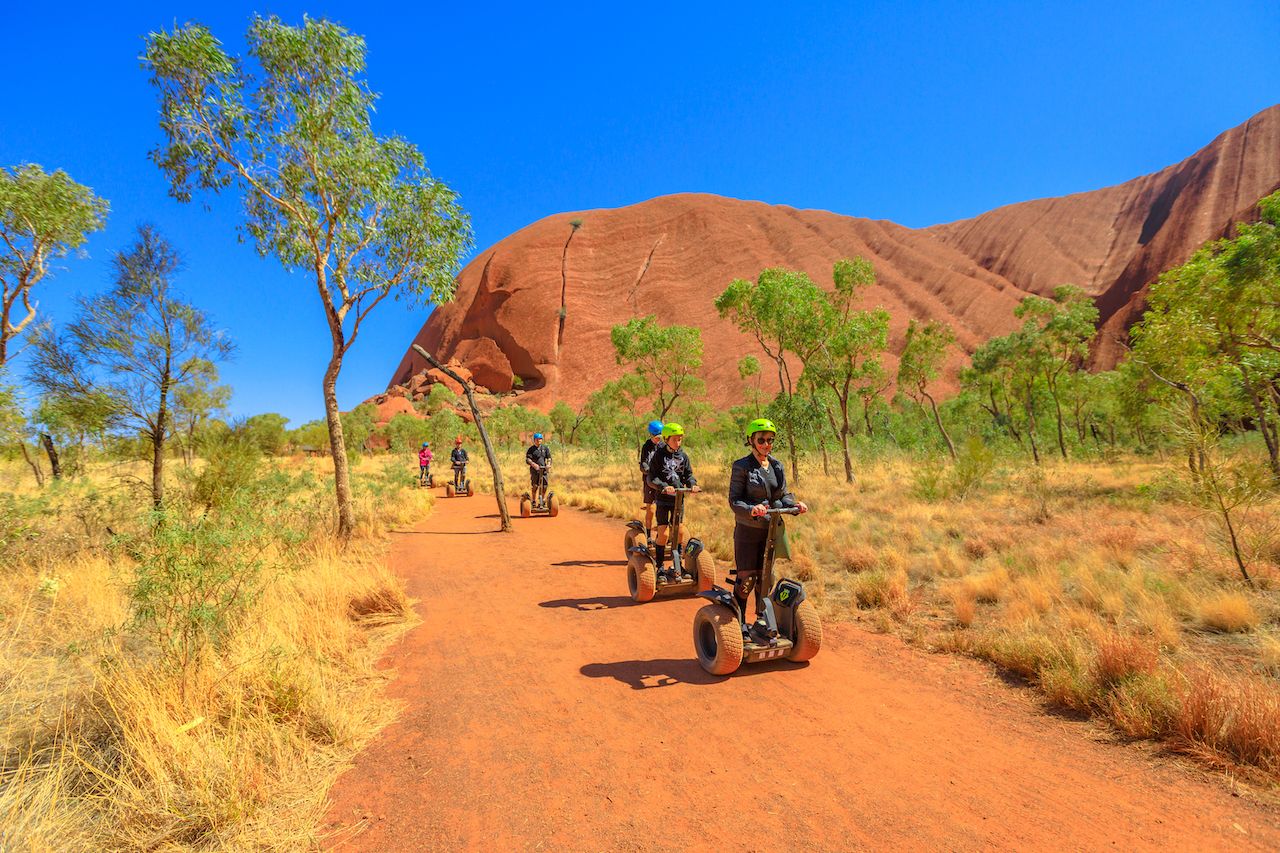
Photo: Benny Marty/Shutterstock
Families with older kids (over 12 years) will be able to experience Uluru on a segway tour, but family members of all ages can book in for an unforgettable scenic helicopter ride, although kids must be accompanied by an adult.
The Domes of Kata Tjuta
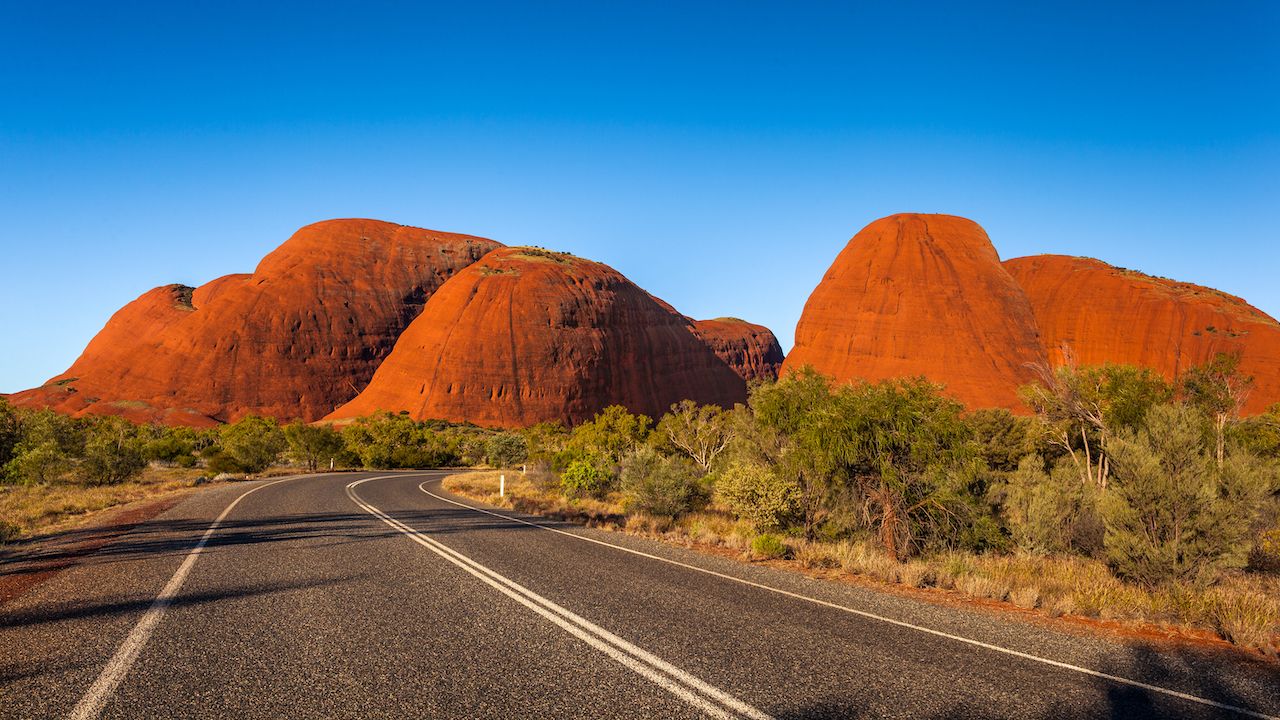
Photo: Maurizio De Mattei/Shutterstock
It’s worth devoting an entire day to the domes of Kata Tjuta, also located within the Uluru-Kata Tjuta National Park roughly 36 miles west of Uluru. Formerly known as ‘The Olgas, it’s just as amazing as Uluru and is, in fact, larger. There are some spectacular walks here that really showcase the surrounding landscape, particularly the Valley of the Winds Walk in which you can run your hands along the ancient giant domes and imagine the stories they would tell, if only they could talk.
There is an entry fee of $28 per adult for a three-day pass to visit Uluru-Kata Tjuta National Park. Children 17 years and younger are free. Most families choose to stay at Ayers Rock Resort, which is close to the national park and offers a range of accommodation from camping through to up-market hotel rooms.
Back to Alice Springs
If time allows you can extend your trip to explore more, but if not, head up the Stuart Highway back to Alice Springs to complete your Central Australia road trip. The journey back to Alice should take around five hours without stopping.